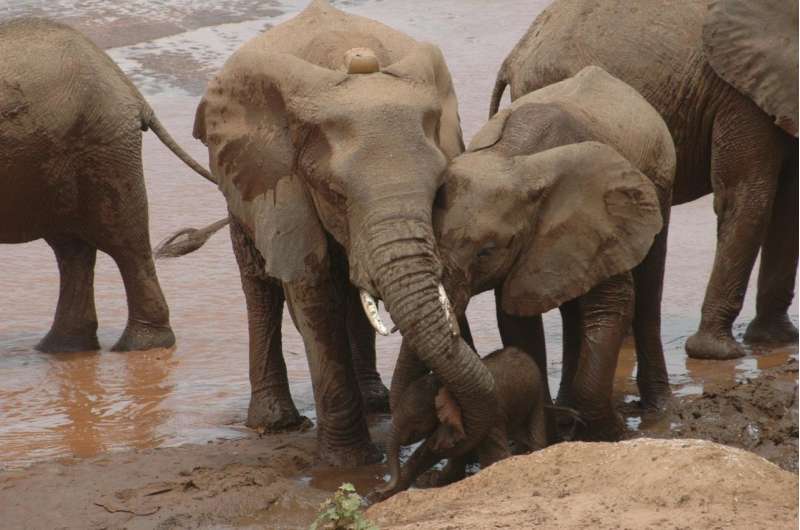An elephant matriarch and her daughter help her youngest calf to her feet in the Ewaso N'giro River in Samburu National Reserve, Kenya. Credit: Shifra Goldenberg/ Save the Elephants and Colorado State University
Young elephants who have lost either their mothers or the matriarchs of their herd are affected dramatically, and change where they live, according to new research from Save the Elephants and Colorado State University.
The study, "Inter-generational change in African elephant range use is associated with poaching risk, primary productivity and adult mortality," is published May 23 in the journal Proceedings of the Royal Society B: Biological Sciences.
By changing home ranges, these survivors alter their exposure to the risk of poaching and can better access green pasture, the study's authors said. This response across generations has important implications for elephants, as the spaces in which they live are increasingly squeezed by swelling human population, farmland and infrastructure.
While most orphaned elephants that the researchers studied expanded their range into novel areas, others decide to "hunker down," and decreased the area over which they would typically range. One family that is well-known to researchers, the Swahili Ladies, abandoned rangeland that lay southwest of protected areas after poaching removed an entire generation of adults. This group then remained largely within the relatively limited confines of the protected area.
"Our study demonstrates that the loss of a matriarch can lead to dramatic shifts and expansions in the movements of some families, while making others much more faithful to the core of their original home range", said lead author Shifra Goldenberg, a postdoctoral researcher in Colorado State University's Department of Fish, Wildlife, and Conservation Biology, and a scientist with the nonprofit conservation organization Save the Elephants.
The research team analyzed the movements of female elephants from nine different families over a 16-year period and found that nearly all of the elephants, including those that did not experience the loss of their matriarch, shifted ranges over time. When they shifted, they tended to move away from known poaching hotspots, and to areas with easier access to food. But the benefits of these shifts in location—in terms of forage or safety—varied.
"The ability to survive in the face of new human pressures is critical to the persistence of wildlife in the face of human global impacts," said senior author George Wittemyer, associate professor at Colorado State University and chairman of the Scientific Board of Save the Elephants.
"In elephants, we see a general ability to recognize high-risk areas and avoid them," Wittemyer added. "But range changes were exaggerated in families that had lost the mothers and leaders of their groups. The costs and benefits of these different types of responses is important to the population's ability to respond to emerging threats and recover from the effects of poaching elephants for ivory, which has reached the level of a serious crisis."
More information: Shifra Z. Goldenberg et al, Inter-generational change in African elephant range use is associated with poaching risk, primary productivity and adult mortality, Proceedings of the Royal Society B: Biological Sciences (2018). DOI: 10.1098/rspb.2018.0286
Journal information: Proceedings of the Royal Society B
Provided by Colorado State University























